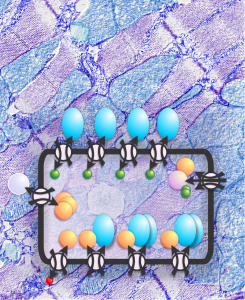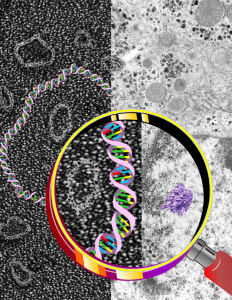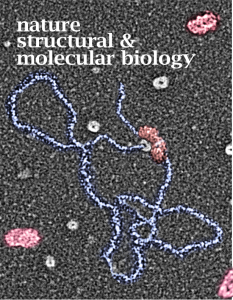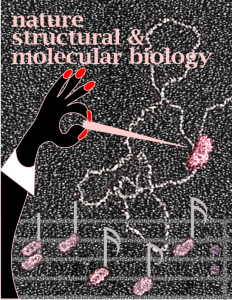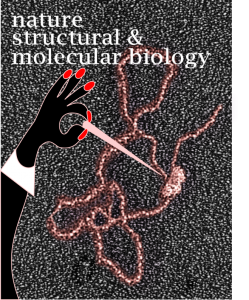This illustration, a background of cardiac muscle cell (mitochondria blue; myofilaments, myofibrils, purple) with an overlay of a rectangle representing a cell (no plasmalemma distinctions on this box) showing some of the ion pumps that are responsible for homeostasis and function in cardiac muscle. This was a cover submission to Journal of Biological Chemistry, years ago, and unfortunately I had two cover submissions for the same month…. this one lost to my other one (ha ha). That was a banner month for me. Two submissions to the same journal but I just wish that either one or the other of the first authors on those manuscripts would have opted to delay publication one month, as I thought this was a pretty good graphic.
Category Archives: Science and art cover illustrations
Too crazy to submit as a cover illustration of an alveolar type II cell diagram
Ha ha…. There are few things in life that I love more than illustrating science. I don’t belong to any group of medical illustrators though this was the dream that began my career in science. I do wish I could send well wishes to long-ago-deceased Lucille Castle Innes who lived next door to me (and the family) at 5252 Windermere in Los Angeles California. It is to her that I give credit for introducing me to scientific illustration.
I remember showing her a diagram of a muscle cell, which apparently I was proud of, and that was likely a school assignment (Eagle Rock High School in the class of a woman whose name I have forgotten (I do, ha ha, think she was the archetypal spinster scientist lady-high school teacher)), but Mrs. Innes mentioned to me that I has not spelled “striated” muscle correctly. Never since have I missed that word. Ha Ha. Mrs Innes not only gave me instructions, inspiration, but also landed me my first job at White Memorial Hospital in LA where I helped sort 2×2 slides of diseases and stuff, watched my first autopsy (lordy, I remember nearly passing out) and watching her work, and receiving guidance when wanting to enroll in a medical illustration degree course (which I did, at the University of Toronto, under the directorship of Nancy Joy).
As life would have it, those aspirations of being a medical illustrator were derailed and I ended up at the University of Cincinnati, in Anatomy, but always illustrated and worked up my own graphics, earning the not so wonderful title from a less than supportive Director of Toxicology during my time in the Department of Environmental Health where I did electron microscopy aka, comparative anatomy and pathology — the Queen of Corel. By way of admission to absolutely loving a program, I have to say CorelDRAW just works for me…. ever since the very first version on 11 little pink floopies, downloaded (probably not legally) from a local print store. Since then, CorelDRAW (versions 4, 6, 10, X3 and 15 have been a life-mainstay). So very different from the hand made stippling and little circles in the first scientific illustrations I did decades ago, now it is diagrams like this one below, of an alveolar type II cell. Just loads of fun, and color appeal but still full of good scientific information.
This particular andy-warhol-style-diagram of a parenchymal cell in the lung was just a little too wild as a cover submission to submit along with my editorial on the ANATOMY OF AN ALVEOLAR TYPE II CELL DIAGRAM .
Nucleated red cell collage
Anatomy is so awesome. The order is fantastic. Our inability at this juncture to understand the massive amount of detail involved in just the function of one single nucleated red cell is overwhelming. Here is such a red cell, electron micrograph originally, which I have pseudo colored, cut pasted, filled and framed. Just look for the mitochondria and vesicles, maybe a little RER in the middle and lower left, and hunt up the nuclear pores and look for the areas condensed and euchromatin, then smile.
There is no “get out of consequences free” card
So here is a thought. Why does one do things that are bad for one’s own health for 45 years, then expect to change suddenly and have their health improve overnight.
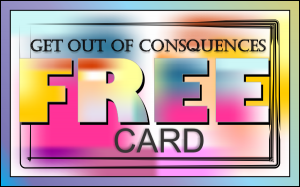 If one has abused one’s own physical body with smoking, or drinking, or sloth, or eating too much, but at age 66 suddenly change lifestyle behavior (quit, abstain, tidy up, eat right, you might think that it is appropriate for the healing to take place in a matter of a few weeks. Biology isn’t like that. If over a 50 year span one has been neglectful, what gives us them the right to expect healing overnight. Forgiveness is a moral issue, there is no forgiveness in biology…. but there is repair, so repair of cells and tissues is biology takes time, a long time. There is no “get out of consequences free” card in biology.
If one has abused one’s own physical body with smoking, or drinking, or sloth, or eating too much, but at age 66 suddenly change lifestyle behavior (quit, abstain, tidy up, eat right, you might think that it is appropriate for the healing to take place in a matter of a few weeks. Biology isn’t like that. If over a 50 year span one has been neglectful, what gives us them the right to expect healing overnight. Forgiveness is a moral issue, there is no forgiveness in biology…. but there is repair, so repair of cells and tissues is biology takes time, a long time. There is no “get out of consequences free” card in biology.
- Doctors (even though they tend to think this) cannot save everyone. Nor should doctors go about the business of pressuring us into having procedures which are good for the “bottom line in profit” but ultimately may affect our health negatively. The same is true for Big Pharma, telling us that we should medicate every ache and pain (largely stemming from our inactivity and innatention).
- We make choices (the up quark and down quark (physicists, forgive me) minute by minute, hour by hour, and so on, and even attempting to do what is biologically right may not work (because of overriding and as yet unclear processes).
- We can repair, this is a good thing, but repair doesn’t come to those who hide.
Cover submission on cleft palate and hydronephrosis
This cover submission didn’t get accepted either. Top row of micrographs represent the palate: left is control, right is cleft. The bottom row of micrographs represent hydronephrosis: left is control, right is experimental. I could look up the conditions that prevailed, but that would be “work”. ha ha.
Cover submission, DNA, transmission electron micrograph, hand lens
This was a pretty outrageous cover submission which wasn’t accepted by the intended journal, but never the less it has come “curb” appeal. I don’t at this point remember which article it was to accompany, or even which journal it was submitted to. I do know it was made for a friend at UNC. And while I have no time at all…. i would be willing to make a cover for some scientist somewhere who was interested in artsie craftsie – but totally scientific illustrations.
Unsuccessful cover submission 1
It is always a little heartbreaking to create a cover submission and have it end up a reject. But rejection is part and parcel for being in science and art both. Below is a fun idea I had (and a variation or two) that apparently didn’t fly with the editors (LOL). And the top image actually did make it into press. Nature structural and molecular biology, 2010, v 17, no 10.
